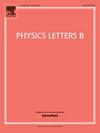通过强透镜和Ia型超新星观测对变化G的研究
IF 4.5
2区 物理与天体物理
Q1 ASTRONOMY & ASTROPHYSICS
引用次数: 0
摘要
本文利用强引力透镜系统和Ia型超新星的数据分析了引力常数G的潜在变化。通过验证G(z)=G0(1+G1z)和G(z)=G0(1+z)G1的G(z)参数化,我们还通过钱德拉塞卡质量-光度关系解释了G对Ia超新星光度的影响。只考虑了平坦宇宙假说。来自158个透镜系统和Pantheon+样本的约束显示没有显著的G变化证据。然而,尽管结果与无变化相容,但误差还没有足够的限制性,不足以以高统计置信度排除G的任何变化。这项研究强调了使用综合天体物理数据来探测基本常数变化的可行性,表明未来的调查可以完善这些限制。本文章由计算机程序翻译,如有差异,请以英文原文为准。
An investigation of a varying G through Strong Lensing and SNe Ia observations
In this paper, we analyze the potential variation of the gravitational constant G using data from strong gravitational lensing systems and Type Ia supernovae. Testing parameterizations where and , we also account for the influence of G on the luminosity of SNe Ia through the Chandrasekhar mass-luminosity relation. Only the flat universe hypothesis is considered. Constraints from 158 lensing systems and the Pantheon+ sample show no significant evidence of G variation. However, although the results are compatible with no variation, the errors are not yet sufficiently restrictive to rule out any variation of G with high statistical confidence. This study highlights the viability of using combined astrophysical data to probe variations in fundamental constants, suggesting that future surveys could refine these constraints.
求助全文
通过发布文献求助,成功后即可免费获取论文全文。
去求助
来源期刊

Physics Letters B
物理-物理:综合
CiteScore
9.10
自引率
6.80%
发文量
647
审稿时长
3 months
期刊介绍:
Physics Letters B ensures the rapid publication of important new results in particle physics, nuclear physics and cosmology. Specialized editors are responsible for contributions in experimental nuclear physics, theoretical nuclear physics, experimental high-energy physics, theoretical high-energy physics, and astrophysics.
 求助内容:
求助内容: 应助结果提醒方式:
应助结果提醒方式:


